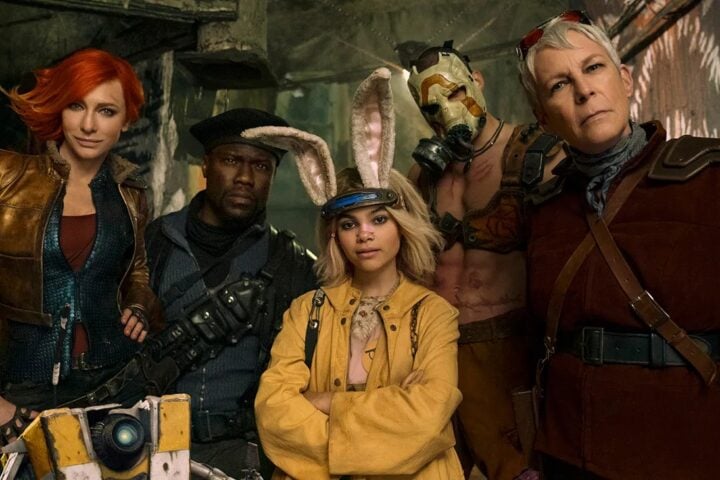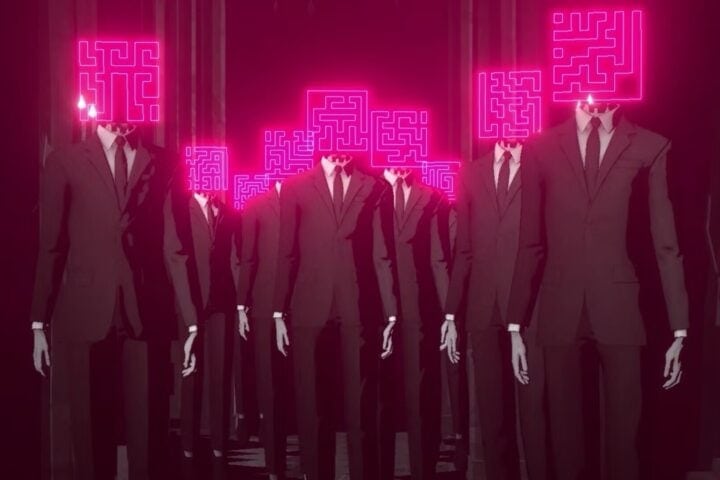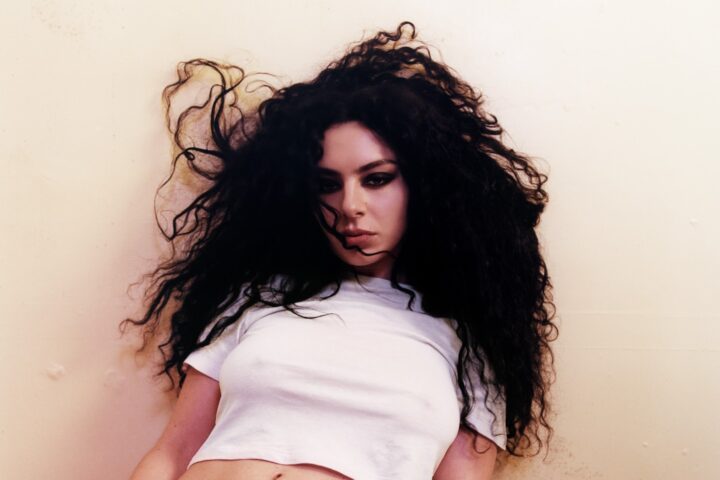Gina Gershon’s body of work boasts a murderer’s row of formidable directors. Following her debut in John Hughes’s Pretty in Pink, she went on to appear in films by John Sayles, Robert Altman, John Woo, Michael Mann, Olivier Assayas, William Friedkin, and Woody Allen. Yet it’s two fateful collaborations in consecutive years—Paul Verhoeven on 1995’s Showgirls and the Wachowskis on 1996’s Bound—that loom largest over her filmography.
As Corky in Bound, Gershon displays a fierce commitment to the physical and emotional realism of a lesbian ex-con trying to restart her life, seamlessly transmuting the brooding of a classic noir protagonist into the body of a contemporary butch plumber. This makes it all the easier to understand how she’d fall for a traditional femme fatale like Jennifer Tilly’s Violet.
The erotic and ecstatic chemistry between the two escalates into an elaborate heist plot to get out from under Violet’s mafia money-laundering husband, Joe Pantoliano’s Caesar. And at every turn, the Wachowskis match the excitement of their story with equally mesmerizing direction.
In a less forgiving era for female stars as sexual beings on screen, Gershon refused to bow to expectations for how and who her characters could love. Her commitment to the stories she wanted to tell came with costs at the time, but she’s been validated by the long arc of film history. Showgirls and Bound are now remembered as signature cinematic achievements of the 1990s, with the former film a mainstay of often cheeky repertory theater programming and the latter recently receiving a new home video release through the Criterion Collection.
I spoke with Gershon shortly after Bound’s new 4K digital restoration was released by Criterion. Our conversation covered how she developed the character of Corky, where the Wachowskis guided her to see the full picture of Bound’s construction on set, and what makes the film such an enduring and endearing queer cinema classic.
Before we start, I should say that I actually studied Bound in a college film class.
It’s a good one for film class because there’s so much to discuss, just technically, the way it was shot, and the meaning of it. That would be fun. Good for that teacher!
You’ve teased writing a more traditional memoir than your 2012 book In Search of Cleo. How would you tell the story of Bound in your book? What’s the enduring memory that lingers on decades later?
I actually am writing another book, and I talk about Bound. My enduring memory of it always was how shocked I was my agents didn’t want me to do it. Everyone literally was saying, “You’re gonna ruin your career.” It was a moment of like, “What are you talking about?” And I realized how homophobic the business was. I just saw an incredible script and a great opportunity. And they’re like, “Oh, it’s a lesbian movie!” You know, people weren’t doing that then. Which, in retrospect, is just insane. It was a good lesson in just standing up for what you believe. And I was like, “This is my career, I’m doing this. I think the Wachowskis are exceptional filmmakers. I want to play Corky. I think this will be cool.” I’m glad I did.
What guides your instincts in picking films and seeing beyond the immediate concerns of agents and publicists?
Oh yeah, I think I had to leave my agents from Showgirls as well! If I had listened to agents or reps saying, “You shouldn’t do this,” I wouldn’t have a career. It seems like every other job I do, they’re like, “You shouldn’t do this.” I’m always open to listening to why I should or shouldn’t. But, ultimately, it’s my decision. And as an artist, if you connect to it or feel strongly about it, that’s what you do. I’ve never thought, “Oh, what will this do for my career?” I don’t think that way. I could tell [Bound] was a special project. We only had 27 days to shoot, but it was so carefully mapped out. I really loved that everyone was so good at what they did, and we just got on with it. Everyone brought the best they could do, and it turned out pretty groovy.
You worked with many visionary directors well into their careers. Could you tell the signs were there for the Wachowskis even though it was their first film?
I get this thing in my stomach: If I meet a really good director—or in this case, directors—I just get giddy. I don’t know why or how I know. But if it’s a really talented person, and the Wachowskis are just geniuses with what they did, I know. Certainly, my agents were like [does a nervous voice], “First-time directors…” And I’m like, “Yeah.” The second I started talking to them about certain shots and how they saw the film, I knew they were very special. And I thought, “I’m in.” It’s exciting to be with first-timers where you say, “I believe in these people doing this.” Sometimes I guess you’re wrong, but I wasn’t surprised how well it turned out.
Were you clocking the Wachowskis’ unconventional filming style with so many close-ups and overhead shots? Does that play into your performance?
No, it’s still the same. You’re still trying to be in the moment and truthful. Instead of just wildly going, “I’m just going to do this,” with certain scenes, they’re like, “No, we need you to look to the left because then we’re going to cut it with the Benjamin Franklin dollar bill looking over to the left.” At first, I’m like, “It feels doesn’t feel right looking this way!” And then they would tell me what they were going to cut it to, and I’d be like, “Ahh, super cool! Okay.” Sometimes directors make the mistake of not clueing in their actors, but that only helped me. I’m a visual person. You can tell me a zillion things, and if you show me something, I’m like, “Oh, yeah, cool!” You want to be part of the team and make that cool image happen. It gave you boundaries of how and where you’re going to be looking. Hopefully, if you do your work, it doesn’t matter.
How did the Wachowskis direct you beyond just getting you to hit your marks? How were they helping you find the character?
Oh, that’s interesting, I don’t really remember them ever doing that! [laughs]
Was it just a matter of them trusting you that much?
When I read for Corky, they liked my reading. To me, Corky was very still like those noir guys or actor men who I always projected everything onto. You can’t help but fall in love with [them]. It was a different, and very still, sort of performance for me. You try not to give away too much. Corky is coming out of jail. She doesn’t trust anyone, so she’s clocking everything. In a lot of those scenes, the audience is learning stuff through Corky’s eyes. I think we were just in cahoots with how that was going on. Maybe [they said], “Amp this or that up,” but it was also a while ago, so I don’t recall. It was more of a physical thing: “You’ve got to look this way.”
Your preparation for the film included looking at swaggering icons like Marlon Brando, Montgomery Clift, and Robert Mitchum. How do those inspirations manifest inside Corky? Is it a matter of incorporating masculinity into the character or blurring the gender binary altogether?
I know, as a woman, what I thought was really sexy when I would look at a man. The way he would hold a beer, certain things as a female looking at a male, I’m like, “Oh, that’s so cool. That’s so sexy.” It was just very quintessential male, like the way they would hold a steering wheel. Those are just like my own little quirks that I love!
It was more of an emotional thing. I started boxing to learn stillness. Instead of being like a [Marvin] Hagler, I wanted to be more like a Sugar Ray [Leonard]. He just moved when he needed to. He was very calm, and I think it was that energy I was tapping into more than anything else. That comes out of you [not wanting] to get hit. It’s a trust issue, who are these people? I didn’t look at it as male or female. I just looked at it as an energy of why they are being that way. It was always very alluring to project onto someone who’s doing…not that you’re doing nothing, but Corky was an interesting character to let people project onto.
It also feels like these characters are consciously playing a part based on what they’ve seen in the culture. Listening to the archival commentary track on the Criterion release, I heard that the Wachowskis gave The Treasure of the Sierra Madre to Joe Pantoliano as a direct influence within a scene.
Interesting, I don’t remember them telling me [to go in that direction]. I go interior-exterior. I just think if you’re someone who’s gauging what is going on and clocking the room and reading the room, it’s not out of insecurity. You don’t give anything away. You don’t make yourself vulnerable in a situation. You just have to figure out: Is this safe? That’s where I think her stillness comes from. Listen, I remember falling in love younger, like, “Oh, he’s so tall, dark, handsome, and quiet.” And then later on, you’re like, “Oh, he’s quiet because he has literally nothing to say!” But you don’t know that at first. And I think there’s something alluring about projecting onto someone and making them much more than they are.
There was some back-and-forth between you and Jennifer on who should play which character in the film. Was each of you having that insight into both Violet and Corky something that helped the production?
I never saw Jennifer [playing Corky]. I think I was playing her [from the start], and then we went to go see Jennifer because they obviously had to see our chemistry. We went to visit her—I want to say Las Vegas, but I could be completely making that up. Jennifer is so animated, so girly, and so like [impersonating Tilly], “Alright, well, you know…” It was so fun to watch! I just thought, “Oh my god, I could do this with her.” As a dude trying to get that energy of just watching some girl, I could watch Jennifer forever and be entertained. And I think there was that element of like, “Who is this creature in front of me?” She’s very alluring, and you could see why Corky would fall in love with Violet even against her better judgment.
How do you feel when the tide starts to shift on a film like Showgirls or Bound? When does the initial reception fade into the background and you can tell it’s been reclaimed as something like a cult classic?
That’s interesting, isn’t it? As soon as Bound came out and people started seeing it, everyone was into it. It was just a matter of the NC-17 from the rating boards. As soon as actors, directors, and regular people started watching the movie, it became a classic instantly.
Showgirls has got its own trajectory. I went to a screening the other night of the film at the Paris Theater. A friend of mine was like, “You have to come and see this,” because I always think I just get PTSD when I watch it. I hadn’t seen it in so long, but seeing it now was so interesting. It’s got a totally different meaning, and maybe people unconsciously were tapping into that. But I find it more interesting that the critics, people who absolutely hated this movie [and said] “this is the worst movie”…to this day, everyone asks me about it. What does that tell you? It’s interesting.
Has the meaning or experience of Bound changed at all for you, especially now knowing it was the project of two transgender women who might not have necessarily had the language or the knowledge to express themselves directly?
I remember asking them, “What do you know about being a woman? How are you going to direct this?” Which feels kind of foolish in retrospect! It certainly had a different meaning to them that I wasn’t aware of. But I think, in general, everyone in that movie is in a box. They’re all bound in some way, and everyone’s trying to become free to be able to be who they are. Of course, we could read so much more into it. I’m sure there’s a reason why they wrote it, but I didn’t know that at the time. I think it’s pretty cool! [laughs]
When you think about the imagery of the closet or even something like the thin walls between the apartments, those feel ripe for symbolic analysis. As you mentioned at the start, it’s a rich text in that way.
I mean, the pipes are all throughout the movie. There’s water, sweat, and wetness. It’s very, very clever. It’s a good thing to have in film school, right? There are a zillion essays [to write] on it.
Have you been involved or consulted on the upcoming stage adaptation of Bound?
I heard about that, but I wasn’t really that aware of it. I mean, it’d be fun to see! Listen, I always felt we were basically doing it in one or maybe two rooms, and I used to say, “God, this could literally be done as a play!” The writing is good enough, although I think so much of the fun of this is the way it looks, the way it’s shot, and the nods to film noir but turning it on its head.
Do you think a version of Corky in 2024 would be played similarly to the way that you played it?
Hopefully, every actress is going to play something differently, but I think the ultimate essence is still the same. To me, it was always a love story. It was about trust. How do you trust someone to give yourself over to them? For me, as Corky, that was the bigger [story]. I never really looked at it like, “Oh, it’s a lesbian, it’s a guy, it’s a girl…” I just thought, “Will I trust this person enough to go all the way in and risk my life?” I’ll be very curious to see what they do with the adaptation. I bet it’ll be cool. I hope it’s cool!
Since 2001, we've brought you uncompromising, candid takes on the world of film, music, television, video games, theater, and more. Independently owned and operated publications like Slant have been hit hard in recent years, but we’re committed to keeping our content free and accessible—meaning no paywalls or fees.
If you like what we do, please consider subscribing to our Patreon or making a donation.




